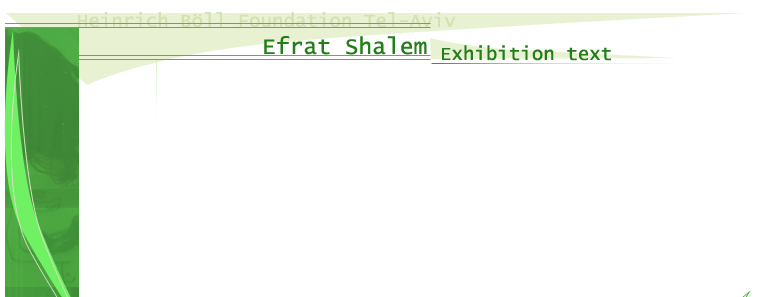


Efrat Shalem
Garden Yard
Street Project # 2
Efrat Shalem was invited to wander about in Tel Aviv, to roam the streets of Ibn Gabirol, Mane, Dubnov, Tzeitlin, King David Blvd., Modigliani, etc., and take pictures. The photographs were presented in the form of a print work - a newsprint pamphlet.
The ability to prompt the living space to converse, to decipher its details, depends on the education of the wanderer or reader. Observing the photographs, landscape architect and local inhabitant Naama Meishar provided us with the names of the plants growing there, among them: Canary Island Pine, Chinaberry, Terebinth, Erythrina Corallodendron, Orchid tree, Livistona Palm, Shrubby Althaea, Nerium Oleander, Wood Sorrels, Dalbergia Sissoo, Carub, Bird of Paradise, Showy Bottlebrush.
Quite an impressive list! The trees are not all local, but rather localized-domesticated. They are originally from Asia, south and north America, and Africa. Certainly not from European countries - the countries from which the neighborhood's inhabitants hailed.
However, while for the experts (e.g., landscape architects, gardeners) the list of plants is interpretable and readable, for the average viewer it is marked as "greenery". The history embodied by the diversity and nature of the greenery, the plants' ages, names and countries of origin are reduced into a small number of signifiers - green, tree, bush, flower, grass, and a single overall signifier: landscape.
The areas of the front and back yards are private territory by law. The artist's viewpoint marked a border point in the urban sphere. The objects of her gaze ostensibly have nothing to hide. However, the "illegal" nature of the gaze and its photographic documentation accentuate the tension between the yard's public accessibility and its private character.
The photographs expose a practice of disregard to an existing private-public space. A flagrant disregard and repression, an attempt to conquer an area emptied of signs of life. The photographs reinforce the latent violence contained in the private-public space photographed by Shalem, questioning our ability to read the space in which we live.
[@LEAD@] The "illegal" nature of the gaze and its photographic documentation accentuate the tension between the yard's public accessibility and its private character
[Titles]
Title texts by Landscape Architect Naama Meishar
1 The wood sorrels cover the area with greenery, generating carpets of radiant green, painfully temporary. Winter treats the gardens kindly: green weeds cover the untended areas too, transforming the gardens into a sequence of bright green. The richness of the green hues stands in contradiction to the "unmanicured" areas, the local heat sprouting in-between the greens.
2 The hedge is the most static element in the neighborhood, both in terms of its durability and in terms of its Cartesian geometrical shape. It is an element that creates the solid partition between the public sphere - the sidewalk, and the semi-private sphere of an apartment building's courtyard.
3 In the past, people used to throw garbage bags in the bins that were located in the backyard. Nowadays, in the era of green dumpsters on the sidewalks, the bin path too has been covered with weeds.
 |
|
|||
|
|
|
|
||
| |
|
|||
|
|
|
 |
|
|
|
|
|
|||
|
|
 |
|
||